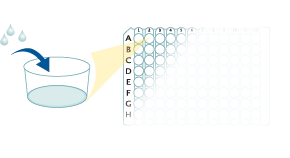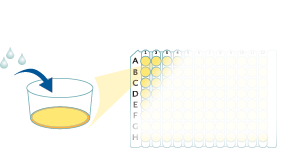Mouse IL-6R alpha Quantikine ELISA Kit Summary
Product Summary
Precision
Cell Culture Supernates, Serum, Heparin Plasma
| Intra-Assay Precision | Inter-Assay Precision | |||||
|---|---|---|---|---|---|---|
| Sample | 1 | 2 | 3 | 1 | 2 | 3 |
| n | 20 | 20 | 20 | 20 | 20 | 20 |
| Mean (ng/mL) | 0.456 | 1.07 | 2.94 | 0.474 | 1.08 | 2.82 |
| Standard Deviation | 0.036 | 0.039 | 0.148 | 0.06 | 0.08 | 0.2 |
| CV% | 7.9 | 3.6 | 5 | 12.7 | 7.4 | 7.1 |
Recovery
The recovery of mouse IL-6 R alpha spiked to levels throughout the range of the assay in various matrices was evaluated.
| Sample Type | Average % Recovery | Range % |
|---|---|---|
| Cell Culture Media (n=4) | 98 | 90-110 |
| Heparin Plasma (n=4) | 99 | 92-106 |
| Serum (n=4) | 102 | 93-110 |
Linearity
Scientific Data
Product Datasheets
Preparation and Storage
Background: IL-6R alpha
IL-6 R alpha is a transmembrane subunit of the receptor for Interleukin-6. It associates with gp130 which is a shared component of the receptors for CLC, CNTF, CT-1, IL-11, IL-27, LIF, and OSM. Soluble forms of IL-6 R alpha are generated by both alternative splicing and proteolytic cleavage. In a mechanism known as trans-signaling, complexes of soluble IL-6 and IL-6 R alpha elicit responses from gp130-expressing cells that lack cell surface IL-6 R alpha. IL-6 plays important roles in the acute phase reaction, inflammation, hematopoiesis, bone metabolism, and cancer progression. IL-6, along with TNF-alpha and IL-1, drives the acute inflammatory response and the transition from acute inflammation to either acquired immunity or chronic inflammatory disease. When dysregulated, it contributes to chronic inflammation in obesity, insulin resistance, inflammatory bowel disease, arthritis, sepsis, and atherosclerosis.
Assay Procedure
Refer to the product- Prepare all reagents, standard dilutions, and samples as directed in the product insert.
- Remove excess microplate strips from the plate frame, return them to the foil pouch containing the desiccant pack, and reseal.
- Add 50 µL of Assay Diluent to each well.
- Add 50 µL of Standard, Control, or sample to each well. Cover with a plate sealer, and incubate at room temperature for 2 hours on a horizontal orbital microplate shaker.
- Aspirate each well and wash, repeating the process 3 times for a total of 4 washes.
- Add 100 µL of Conjugate to each well. Cover with a new plate sealer, and incubate at room temperature for 2 hours on the shaker.
- Aspirate and wash 4 times.
- Add 100 µL Substrate Solution to each well. Incubate at room temperature for 30 minutes on the benchtop. PROTECT FROM LIGHT.
- Add 100 µL of Stop Solution to each well. Read at 450 nm within 30 minutes. Set wavelength correction to 540 nm or 570 nm.





Citations for Mouse IL-6R alpha Quantikine ELISA Kit
R&D Systems personnel manually curate a database that contains references using R&D Systems products. The data collected includes not only links to publications in PubMed, but also provides information about sample types, species, and experimental conditions.
2
Citations: Showing 1 - 2
Filter your results:
Filter by:
-
Enhanced Interleukin 6 Trans-Signaling Modulates Disease Process in Amyotrophic Lateral Sclerosis Mouse Models
Authors: Milligan, C;Cowley, DO;Stewart, W;Curry, AM;Forbes, E;Rector, B;Hastie, A;Liu, L;Hawkins, GA;
Brain sciences
Species: Transgenic Mouse
Sample Types: Serum
-
Microenvironmental IL-6 inhibits anti-cancer immune responses generated by cytotoxic chemotherapy
Authors: EH Bent, LR Millán-Bar, I Zhuang, DR Goulet, J Fröse, MT Hemann
Nature Communications, 2021-10-28;12(1):6218.
Species: Mouse, Transgenic Mouse
Sample Types: Cell Culture Supernates
FAQs
-
Assay Diluent RD1-14 contains visible precipitate. Is this acceptable to use?
A small amount of precipitate is expected and acceptable in Assay Diluent RD1-14. Variability has been observed between vials and diluent lots. It may not fully resolubilize but this will not impact assay performance. It is not recommended to filter the precipitate.
Reviews for Mouse IL-6R alpha Quantikine ELISA Kit
Average Rating: 5 (Based on 1 Review)
Have you used Mouse IL-6R alpha Quantikine ELISA Kit?
Submit a review and receive an Amazon gift card.
$25/€18/£15/$25CAN/¥75 Yuan/¥2500 Yen for a review with an image
$10/€7/£6/$10 CAD/¥70 Yuan/¥1110 Yen for a review without an image
Filter by:
Great kit.







